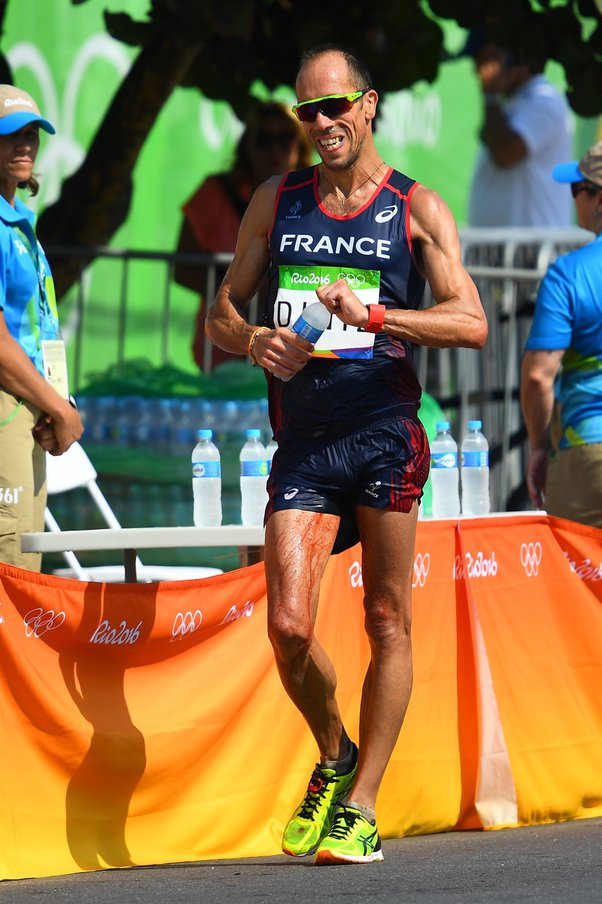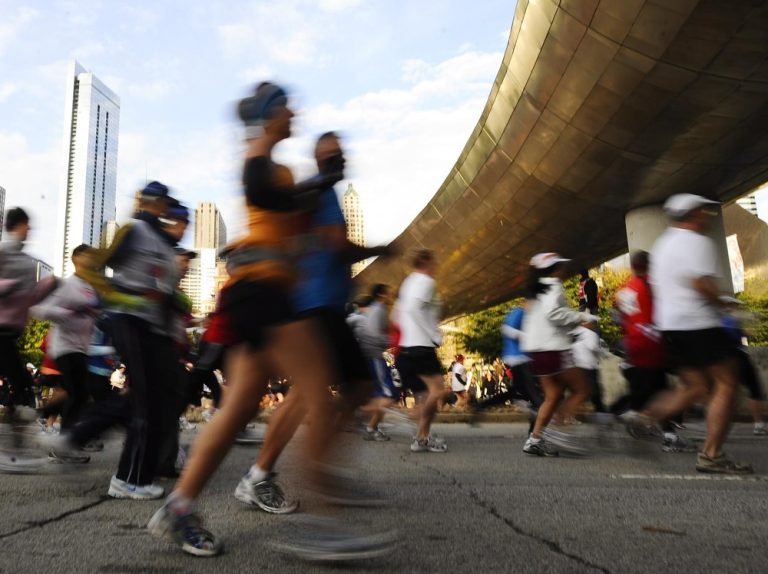How Do Marathon Runners Pee
Marathon runners often pee while running by doing so discreetly and on the move. Marathon runners occasionally face the need to relieve themselves during a race, and this can be a tricky task.
While it may seem like a daunting challenge, experienced runners have developed strategies to urinate during a race without hindering their performance or causing discomfort to themselves or others. We will explore the methods used by marathon runners to pee during a race, the etiquette involved, and the importance of staying hydrated while maintaining race pace.
So, if you’ve ever wondered how marathon runners manage this bodily function during a race, keep reading to discover their secrets.

Credit: www.news24.com
Challenges During A Marathon
Challenges during a marathon can be intense, both physically and mentally. Marathon runners need to navigate through various obstacles, from pushing their bodies to the limit to dealing with logistical issues like bathroom breaks. Let’s delve into some of the challenges that marathon runners face and how they overcome them.
Limited Opportunities For Bathroom Breaks
During a marathon, finding a suitable time and place for a bathroom break can be extremely challenging. With thousands of runners and limited facilities along the course, stopping for a bathroom break can lead to significant time loss and disruption to a runner’s rhythm.
Risk Of Discomfort And Distraction
Marathon runners face the risk of discomfort and distraction when dealing with the urge to urinate during the race. The physical discomfort of a full bladder can hinder a runner’s performance, while the mental distraction of needing to pee can negatively impact their focus and motivation.

Credit: patch.com
Strategies To Manage Urination During A Marathon
During a marathon, runners utilize quick stops and discreet methods like using specialized gear or relieving themselves on the go to manage urination without affecting their running performance. It’s a well-known practice among seasoned marathoners to maintain focus and endurance throughout the race.
Timing Fluid Intake
Timing your fluid intake is crucial when it comes to managing urination during a marathon. It’s important to strike a balance between staying hydrated and avoiding the urge to constantly pee.
Here are a few strategies to help you with timing your fluid intake:
- Avoid excessive fluid intake within one hour of the race start. Large amounts of fluids consumed right before the race can lead to the need to urinate frequently.
- Sip fluids consistently throughout the race. Instead of chugging a lot of water at once, aim for small sips at regular intervals. This helps to maintain hydration without overwhelming your bladder.
- Monitor your body’s hydration cues. Thirst is a good indicator of when you need to replenish fluids. Listen to your body and drink accordingly.
- Avoid high-sodium foods and beverages. Consuming excessive sodium can increase dehydration, leading to more frequent urination.
Strategic Clothing Choices
Choosing the right clothing can also make a difference in managing urination during a marathon. Here are a few strategies to consider:
- Opt for easily accessible clothing. Wearing clothing with easy-to-reach zippers or stretchy waistbands can make bathroom breaks quicker and more efficient.
- Consider wearing dark-colored or patterned bottoms. This can help camouflage any potential accidents or spills during the race.
- Choose moisture-wicking fabrics. Moisture-wicking materials draw sweat away from the body, helping to keep you dry and comfortable, reducing the need for unscheduled bathroom breaks.
- Try wearing compression shorts or tights. These can provide extra support and minimize the feeling of needing to urinate.
Techniques For Peeing During A Marathon
Marathon runners often use discreet techniques to urinate during races, like opting for appropriate clothing and strategically planning bathroom stops. Some choose to relieve themselves while running, such as by slowing down and doing so in secluded areas. Overall, careful planning and practice are key for runners to handle this common challenge during a marathon.
When it comes to running a marathon, endurance and determination are critical for success. But what about the inevitable need to use the bathroom? Marathon runners face the challenge of managing their bodily functions while maintaining their pace. In this post, we will explore some ingenious techniques that marathon runners employ to answer the question: “How do marathon runners pee?”
Side-of-the-road Pit Stops
One common technique marathon runners use to relieve themselves is by taking side-of-the-road pit stops. This involves finding a discrete location, off the main course, where they can quickly and efficiently take care of their bathroom needs. Runners often scope out areas with trees or shrubbery, ensuring privacy while staying mindful of their surroundings.
Utilizing these pit stops require runners to plan accordingly, especially during races with fewer bathroom facilities along the course. Experienced marathoners strategize their fluid intake, balancing hydration needs with the desire to limit the number of pit stops.
Utilizing Hygiene Products
Another technique marathon runners employ is the use of hygiene products to help manage their bathroom needs. One popular choice is the pee funnel, a small device that enables runners to urinate while on the move. These funnels are designed for both men and women and can easily be tucked into a pocket or waistband, making them a convenient and discreet option. By using hygiene products, runners can avoid the need for lengthy stops and maintain their momentum.
Other hygiene products, such as absorbent pads or portable urinals, are also used by some runners to minimize the impact of bathroom breaks on their race time. These products offer a practical solution that allows runners to stay focused on the race without compromising their comfort.
Impact Of Peeing On Performance
Marathon runners employ strategic techniques for peeing during races to minimize the impact on their performance and maintain their pace. These methods include finding secluded spots and using compression shorts with built-in openings.
Impact of Peeing on Performance As marathon runners know, any interruption during a race can impact their overall performance. Peeing during a marathon is a common challenge that many runners face. The decision to relieve oneself mid-race can impact a runner’s focus, rhythm, and overall race time. Let’s delve into the potential time loss and psychological factors associated with this biological necessity.Potential Time Loss
Pee breaks during a marathon can lead to a significant time loss. According to the RunnersConnect online coaching platform, stopping for a bathroom break can add anywhere from 60 seconds to 2 minutes to a runner’s overall time. This time loss is not only due to using the restroom but also the interruption to the runner’s rhythm and focus. For elite runners, this pause can even mean the difference between securing a top position and falling behind.Psychological Factors
The need to urinate during a marathon can create psychological stress for runners. The pressure of needing to pee but not wanting to lose time can generate anxiety, leading to a distraction from the race itself. Runners might also experience a mental struggle between the discomfort of a full bladder and the reluctance to take a break. This internal battle can also impact a runner’s focus and overall performance. In summary, the impact of needing to pee during a marathon goes beyond just the physical inconvenience. It presents challenges that can affect a runner’s time and mindset, potentially impacting their overall performance. Understanding and addressing these factors is crucial for marathon runners aiming to optimize their race experience.Ethical Considerations And Race Rules
Marathon runners must carefully consider ethical and race rules when it comes to addressing the question of how they handle bathroom breaks during a race.
Respecting Fellow Competitors
Marathon runners must respect the challenges faced by fellow competitors.
Competitors should avoid disrupting others’ race experiences.
Runners are encouraged to maintain a sense of sportsmanship throughout the event.
Navigating Event Regulations
Runners should adhere to the specific pee break rules set by the race organizers.
Understanding event guidelines ensures a fair and ethical competition for all.
It is important to comply with the marathon regulations to avoid penalties.

Credit: www.quora.com
Frequently Asked Questions On How Do Marathon Runners Pee
What Do Marathon Runners Do When They Need The Toilet?
Marathon runners use portable toilets along the course or find natural spots for privacy. They plan their fluid intake and use restrooms before the race.
What Do You Do When You Have To Pee During A Marathon?
During a marathon, use portable toilets along the route or wait for next aid station.
How Do You Use The Bathroom While Running A Marathon?
Plan ahead to use portable toilets along the marathon route for bathroom breaks. Practice stopping and starting to minimize time lost.
Conclusion
Marathon runners have various methods to manage bathroom breaks during a race, including using adult diapers or strategically choosing race routes. The decision to pee during a marathon is a personal one, but it’s clear that many runners have found creative solutions to this common challenge.
Ultimately, staying focused and adapting to unforeseen circumstances are essential skills for any marathon runner.






